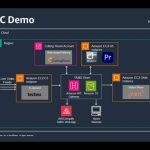Netflix, Couchbase, Supercell, and Fox Corporation are among thousands of customers who will use AWS Local Zones.
Amazon Web Services, Inc. has announced the completion of its first 16 AWS Local Zones in the US and plans to launch new AWS Local Zones in 32 new metropolitan areas in 26 countries around the world.
AWS Local Zones place compute, storage, database, and other AWS services at the edge of the cloud near large population, industry, and information technology (IT) centres—enabling customers to deploy applications that require single-digit millisecond latency closer to end users or on-premises data centres. AWS Local Zones allow customers to use core AWS services locally while connecting to the rest of their workloads running in AWS Regions with the same elasticity, pay-as-you-go model, application programming interfaces (APIs) and toolsets.
Over the next two years, new AWS Local Zones will launch in Amsterdam, Athens, Auckland, Bangkok, Bengaluru, Berlin, Bogotá, Brisbane, Brussels, Buenos Aires, Chennai, Copenhagen, Delhi, Hanoi, Helsinki, Johannesburg, Kolkata, Lima, Lisbon, Manila, Munich, Nairobi, Oslo, Perth, Prague, Querétaro, Rio de Janeiro, Santiago, Toronto, Vancouver, Vienna and Warsaw.
Whilst noting that the vast majority of its customers receive the necessary latency required to support their applications’ performance by running them in the AWS Region, AWS added that for applications that require ultra-low latency – such as media and entertainment content creation and live video streaming – customers want AWS infrastructure closer to their end users to support a “seamless” experience.
Without the dedicated infrastructure, AWS noted that such use cases will otherwise require customers to procure, operate, and maintain IT infrastructure—and use a different set of APIs and tools for the on-premises and AWS environments—which could create unnecessary costs and operational complexity. AWS said that the new AWS Local Zones will give customers around the world the ability to offer hundreds of millions of end users single-digit millisecond performance for their applications.
Commenting on the development, Prasad Kalyanaraman, Vice President of Infrastructure Services at AWS, said: “The edge of the cloud is expanding and is now becoming available virtually everywhere. Thousands of AWS customers using US-based AWS Local Zones are able to optimize low-latency applications designed specifically for their industries and the use cases of their customers. With the success of our first Local Zones in 16 US cities, we are expanding to more locations for our customers around the world who have asked for these same capabilities to push the edge of cloud services to new places. AWS Local Zones will now be available in over 30 new locations globally, providing customers with a powerful new capability to leverage cloud services within a few milliseconds of hundreds of millions of end users around the world.”
Subscription video-on-demand major Netflix is one of the companies set to benefit from the move, as its business has 214m paid memberships in over 190 countries.
Stephen Kowalski, Director of Digital Production Infrastructure Engineering at Netflix, added: “Netflix is poised to become one of the world’s most prolific producers of visual effects and original animated content. To meet that demand, we are hiring the best artistic talent from all over the world. These artists need specialised hardware and access to petabytes of images to create stunning visual effects and animations. Historically, artists had specialized machines built for them at their desks; now, we are working to move their workstations to AWS to take advantage of the cloud. In order to provide a good working experience for our artists, they need low latency access to their virtual workstations. AWS Local Zones brings cloud resources closer to our artists and have been a game-changer for these applications. By taking advantage of AWS Local Zones, we have migrated a portion of our content creation process to AWS while ensuring an even better experience for artists. We are excited about the expansion of AWS Local Zones globally, which brings cloud resources closer to creators, allowing artists to get to work anywhere in the world and create without boundaries.”
Other companies that will benefit from this move includes Couchbase, Supercell, Fox Corporation, Edgegap, Ubitus, JackTrip Labs, JamKazam, and Esports Engine, among others.
Couchbase delivers a modern database for enterprise applications. Wayne Carter, Vice President of Engineering at Couchbase, stated: “The database is just as critical to edge computing as the infrastructure and network. Apps that are stateful and need to store data require a modern database. And that database needs to be able to operate and synchronize across the entire architecture, not just on a single edge device or endpoint. Couchbase is using AWS Local Zones to provide low latency and single-digit millisecond database access times for applications, ensuring developers’ apps are always available and fast. Using AWS Local Zones, along with Couchbase’s edge computing capabilities, means that our customers are able to store, query, search, and analyze data in real-time with high availability.”
Finland-based mobile game developer Supercell has brought five chart-topping games to the market: Hay Day, Clash of Clans, Boom Beach, Clash Royale, and Brawl Stars.
Juho Mäkinen, Lead of Infrastructure and Services at Supercell, commented: “Our player base has scaled at an incredible pace, and we have relied on AWS to manage our infrastructure and match our growth. We deploy game servers in multiple AWS Regions today to serve our end users globally and evaluate all new Regions as they come online. We are also using AWS Local Zones as deployment targets in the US, and we are considering additional Local Zones as they become available in order to bring the latency-sensitive portions of game servers closer to more end users.”
For its part, Fox Corporation said that with AWS Local Zones in close proximity to its production hubs, shoots and the Fox lot, it was able to deliver cloud resources directly to artists allowing them to work without the limitations of traditional remote solutions.
Christian Kennel, Vice President Post and Production Technology at Fox Entertainment, remarked: “Home to exceptional artists, it’s our mission to find and leverage technology which removes any friction or barrier from the creative process, allowing our storytellers to focus solely on the content, not the way it’s created. With AWS Local Zones in close proximity to our production hubs, shoots, and the famed Fox lot, we’re able to deliver cloud resources directly to our artists, allowing them to craft their vision without the limitations of traditional remote solutions. Creative workflows like editorial, motion graphics, and finishing demand ultra-low latency, and AWS represents the best of breed solution that Fox has come to rely upon. Integrating AWS into the Fox workflow enables us to execute and deploy much faster, taking us closer to the goal of allowing artists to create from the field, the home, or the lot, with seamless access to every resource necessary to create the award-winning content for which Fox is known. ”
Mathieu Duperré, CEO at Edgegap Technologies, said: “Providing the best online experience to our players logging in from all over the world is our competitive advantage. High or unstable latency is detrimental to our end-user experience and ultimately to revenue in gaming. With AWS Local Zones, Edgegap can now deploy even closer to where the players are, elevating their gaming experience to new heights. This means our clients like Die by the Blade game maker, Triple Hill Interactive, can successfully run a one-versus-one global tournament online, or the makers of fast-paced arena shooter Brutal Grounds, Agog, can now provide a fair environment for every gamer anywhere.”

















































































